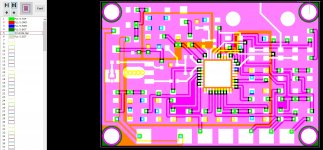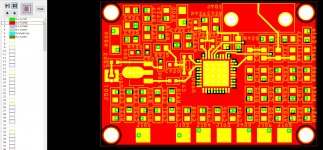I am trying to manually solder parts on a 4 layers board I designed myself; it's the first time I'm using a 1mm thick board. Don't mention "reflow", I got burned too bad to try it again.
3 out of 4 layers are essentially ground planes. Parts are small 0402 and DFN. I soldered such parts using both hot air and my Metcal tools many times, an 2 layers boards 0.8mm thick with ground planes countless times, without any problems.
Now I hit a wall. Nothing solders properly, 63/37 doesn't flow and wet any pad via connected to ground planes, even with the hot air tool set to 420C, which is huge for Sn/Pb. The otherwise excellent Metcal tools also don't melt the 63/37 in those pads.
Obviously it's a heat dissipation issue, these little boards (2"x2" so far) appear to be excellent heat sinks, and I would expect even worse as the board size increases. The obvious solution is to use a hot plate preheater, and I'm ready to invest in one, but which model? There's plenty of models on EBay, but quality is ???, while a Metcal model is rather pricey and is very basic. Anybody has any experience with these tools? Not expecting any boards larger that (say) 6"x4".
3 out of 4 layers are essentially ground planes. Parts are small 0402 and DFN. I soldered such parts using both hot air and my Metcal tools many times, an 2 layers boards 0.8mm thick with ground planes countless times, without any problems.
Now I hit a wall. Nothing solders properly, 63/37 doesn't flow and wet any pad via connected to ground planes, even with the hot air tool set to 420C, which is huge for Sn/Pb. The otherwise excellent Metcal tools also don't melt the 63/37 in those pads.
Obviously it's a heat dissipation issue, these little boards (2"x2" so far) appear to be excellent heat sinks, and I would expect even worse as the board size increases. The obvious solution is to use a hot plate preheater, and I'm ready to invest in one, but which model? There's plenty of models on EBay, but quality is ???, while a Metcal model is rather pricey and is very basic. Anybody has any experience with these tools? Not expecting any boards larger that (say) 6"x4".
Either get a wagner paint stripper heat gun from your local hardware store and use it to preheat the boards, or use a front loading toaster oven and you can watch your parts through the window. You can use an old wire shelf to hold your boards while you heat around it and solder around it. You just need to preheat it well enough. The wagner that i use has two settings, I use one for just preheat, and the other for actually getting solder paste to melt
S
S
How about an old fashioned kitchen hotplate with a 1/4" thick piece of aluminum on it. They usually have some sort of control to regulate the temperature. Use one of those non contact thermometers. If you have a big variac you could regulate it with that also.
I keep one around for mounting expensive precision bearings on machine tools.
Billwojo
I keep one around for mounting expensive precision bearings on machine tools.
Billwojo
yeah it sounds like you need to bring everything up to re-flow temp, use some paste, stencil. Ability to soldering by hand would depend on the pad stack design, do you have full contact vias, vias in pads, thermal reliefs in the padstack?
The hot plate is the cheapest set of equipment to use, but that may depend on if it is double sided components, can it sit flat on the plate. Dwell and soak time are important as to if you will do damage, de-laminate, hard to control with crude methods. If the components ( IC's ) have had moisture absorption, they could pop corn on you, de-laminate, break internal bond wires etc. Usually the suppliers, add the moisture indicators in the sealed bags, once you open the bags you are supposed to solder ASAP or op in a dry/nitrogen controlled humidity environment, if not pre-bake them again on a low heat to drive the moisture back out before re-flow. best advise I can offer you without visualizing your layout and see how you designed the pcb.
The hot plate is the cheapest set of equipment to use, but that may depend on if it is double sided components, can it sit flat on the plate. Dwell and soak time are important as to if you will do damage, de-laminate, hard to control with crude methods. If the components ( IC's ) have had moisture absorption, they could pop corn on you, de-laminate, break internal bond wires etc. Usually the suppliers, add the moisture indicators in the sealed bags, once you open the bags you are supposed to solder ASAP or op in a dry/nitrogen controlled humidity environment, if not pre-bake them again on a low heat to drive the moisture back out before re-flow. best advise I can offer you without visualizing your layout and see how you designed the pcb.
Last edited:
Yeah, it's of the worse kind, with vias in the pads and thermal relief in the padstack. 3 out of four layers (GND, PWR routing, BOT routing) are essentially ground planes or have heavy copper pours. I'm attaching two views, 1 is all four layers, 2 is TOP (controlled impedance and a couple of routing traces), GND, silk screen, and drill layers. Board size is 1.5" x 1" parts are mostly 0603, some 0402 too. After much effort, I assembled one board manually and it's working fine...
I posted yesterday a message about, not sure why it did not appear (or was deleted). I found the comment about the paint stripper heat gun rather funny in this context 😀. Meantime, I pulled the trigger on an Aoyue AO853++ hot plate, the last one in stock at DigiKey, will get it on Monday. Has controlled temperature with two temperature sensors, and can even program a reflow cycle, with ramping, etc... But the plan is to use it at a constant minimum temperature (like 100C), just enough to allow the iron or the hot air to melt and flow the 63/37, and only for the difficult parts, like the DFN chips. The only major concern is how long I will be able to keep my hands over the board for manual soldering. The 853++ is not ideal, has mixed reviews, but is certainly affordable.
As I said, I had a pretty bad experience with reflow ovens + stencils assembly, the quality was poor, plus that and I found the cost of good solder paste outrageous (plus poor conservation properties, even in the fridge). If I will ever do anything but prototype boards (meaning >10 pc., unlikely) I'd rather let the board shop do the assembly, they can source any parts with a minimum overhead, and keep only the rework for myself, if needed.
I posted yesterday a message about, not sure why it did not appear (or was deleted). I found the comment about the paint stripper heat gun rather funny in this context 😀. Meantime, I pulled the trigger on an Aoyue AO853++ hot plate, the last one in stock at DigiKey, will get it on Monday. Has controlled temperature with two temperature sensors, and can even program a reflow cycle, with ramping, etc... But the plan is to use it at a constant minimum temperature (like 100C), just enough to allow the iron or the hot air to melt and flow the 63/37, and only for the difficult parts, like the DFN chips. The only major concern is how long I will be able to keep my hands over the board for manual soldering. The 853++ is not ideal, has mixed reviews, but is certainly affordable.
As I said, I had a pretty bad experience with reflow ovens + stencils assembly, the quality was poor, plus that and I found the cost of good solder paste outrageous (plus poor conservation properties, even in the fridge). If I will ever do anything but prototype boards (meaning >10 pc., unlikely) I'd rather let the board shop do the assembly, they can source any parts with a minimum overhead, and keep only the rework for myself, if needed.
Attachments
Last edited:
My favorite is a convection toaster oven. Start at a medium temperature and then bump up to the proper bake temp for a few minutes. Using convection, it heats evenly and doesn't burn anything. Once that does all the smd, then I use the Wagner for misc items like capacitor and other devices that can't take the heat on them but have large heat soaking and in places where the board soaks up the heat into a plane or other.. My boards are over 20cm in each direction and 4lyr. They won't solder tip without extra heat applied.
You may have to use a higher heat than you think because the plate will absorb heat if it's lower in temperature than the iron. Should work out for you tho.
You may have to use a higher heat than you think because the plate will absorb heat if it's lower in temperature than the iron. Should work out for you tho.
- Home
- Design & Build
- Construction Tips
- Soldering a 4 layers board

